Physical Address
304 North Cardinal St.
Dorchester Center, MA 02124
Physical Address
304 North Cardinal St.
Dorchester Center, MA 02124
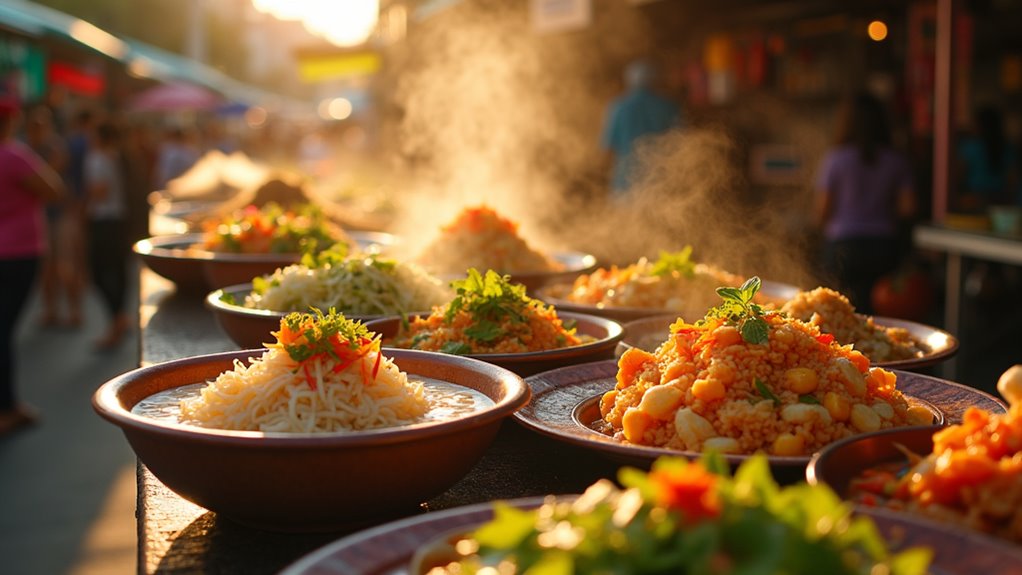
Glimpse into Thailand's vibrant food culture through 9 mouthwatering dishes that will transform your culinary adventure forever.
Thai food culture offers a feast of bold flavors and contrasting elements. You’ll find signature dishes like spicy-sour Som Tam (papaya salad), iconic Pad Thai noodles, fragrant Tom Yum Goong soup, opulent Green Curry, and Northern Khao Soi curry noodles. Don’t miss street food adventures featuring satay skewers and sweet mango sticky rice. Each region presents distinctive specialties influenced by geography and cultural heritage, from spicy Isaan cuisine to seafood-rich Southern dishes. Discover how these culinary treasures tell Thailand’s delicious story.
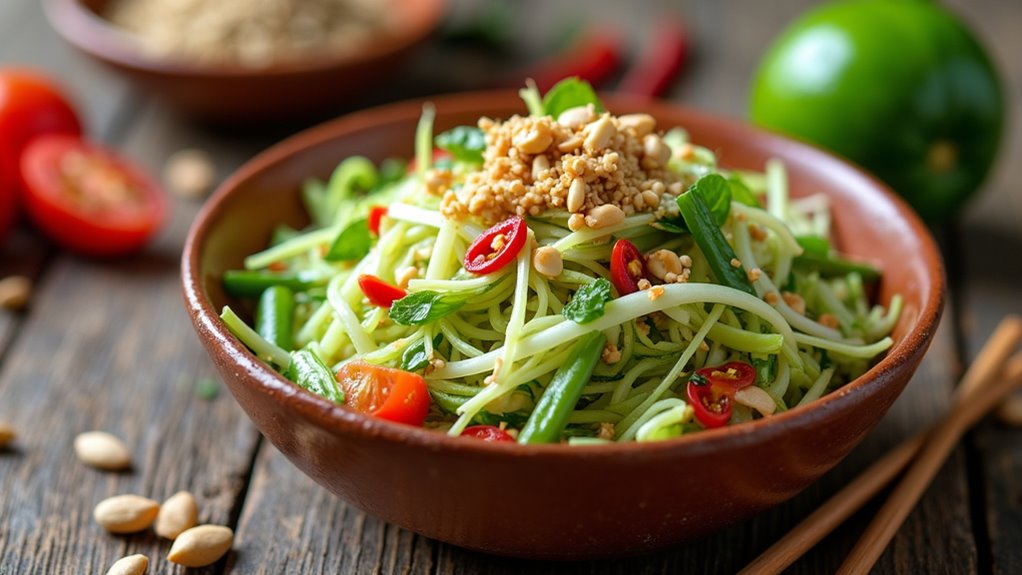
When visiting Thailand, you’ll quickly discover that som tam stands as one of the country’s most beloved culinary treasures. This northeastern dish features shredded unripe green papaya pounded with garlic, chilies, dried shrimp, and peanuts in a mortar and pestle.
The name perfectly describes the preparation—”som” means sour and “tam” means pound. Each bite delivers an explosion of contrasting flavors: spicy chilies, tangy lime juice, savory fish sauce, and sweet palm sugar.
The symphony of som tam reveals itself with each pounded ingredient—a dance of sour, spicy, salty and sweet.
The crisp papaya, softened peanuts, and juicy tomatoes create textural harmony. The traditional preparation technique involves light pounding to release the ingredients’ flavors while maintaining their distinctive textures rather than turning them into a paste.
Look for regional variations like som tam Lao with fermented fish sauce or som tam pu with raw blue crab. While exploring Thai islands like Koh Lanta or Koh Samui, you’ll find local interpretations of this dish with varying spice levels to accommodate travelers. Always enjoy it with sticky rice and grilled meats for an authentic Isaan experience.
If you’ve ever tasted Thai cuisine, you’ve likely encountered pad Thai, the country’s most internationally recognized dish. Developed in the 1930s as a symbol of national unity, this stir-fried noodle dish has become Thailand’s culinary ambassador worldwide.
The magic of pad Thai lies in its balanced flavor profile—sweet, sour, salty, and umami. Rice noodles form the base, complemented by proteins like shrimp, chicken, or tofu. The signature sauce combines fish sauce, tamarind, and brown sugar, while aromatics like garlic and shallots add depth. For authentic preparation, traditional Thai chefs recommend using tamarind paste from Thailand rather than concentrated Indian varieties with seeds. Everything is stir-fried at high heat, then topped with crunchy peanuts, fresh bean sprouts, and herbs.
You’ll find endless variations across Thailand, each customized to regional preferences and spice tolerance. Many visitors to Koh Phangan enjoy sampling pad Thai while watching the sunset spots that offer breathtaking views across the island.
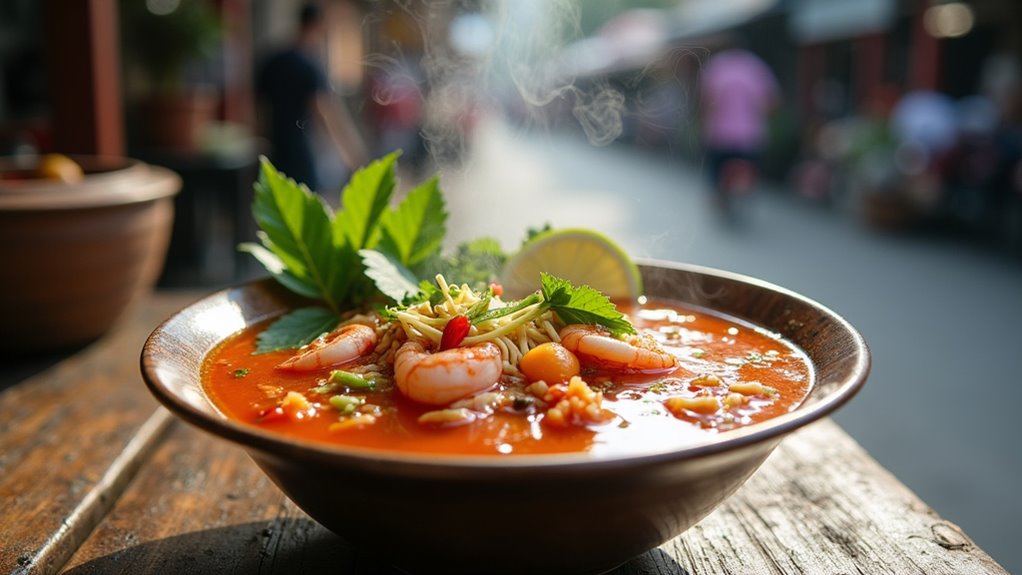
Tom Yum Goong stands as Thailand’s signature soup, enchanting diners with its perfect balance of fiery spice and tangy citrus notes. This aromatic bowl combines the “tom yum trinity” of lemongrass, galangal, and makrut lime leaves with plump shrimp and mushrooms.
You’ll find two main versions: the clear broth original or the creamier “nam khon” with evaporated or coconut milk. Many consider tom yum goong to be a potential national dish of Thailand due to its widespread popularity. Watch as locals season their soup incrementally with fish sauce, lime juice, and a touch of sugar until the flavor perfectly balances sour, spicy, salty, and sweet.
While traditionally made with freshwater shrimp, you’ll encounter variations with chicken, fish, or mushrooms. Whether you’re exploring the vibrant beach scenes of Koh Phangan or Phuket, you’ll find this iconic soup featured prominently on menus throughout Thailand. Don’t miss trying the street food version, often served alongside rice for a complete meal.
Revered across Thailand for its vibrant green color and complex flavor profile, Green Curry (Geang Keow Wan) represents one of the kingdom’s most beloved culinary treasures. You’ll find this dish combines aromatic green curry paste with creamy coconut milk, creating an opulent, velvety texture.
The magic happens when makrut lime leaves, palm sugar, and fish sauce blend together, balancing spicy, sweet, and savory notes. Typically featuring chicken or tofu, it’s adorned with Thai eggplant and fresh sweet basil. Traditional preparation involves cooking until the coconut milk separates into layers, which creates the curry’s distinctive richness.
Regional variations might include different proteins like shrimp or less coconut milk for a lighter consistency.
Beyond its delicious taste, green curry offers nutritional benefits from antioxidant-rich chilies and medicinal herbs like galangal and lemongrass. Many travelers enjoy sampling this authentic dish between visits to ethical sanctuaries where they can observe elephants being treated humanely. It’s a perfect introduction to Thailand’s harmonious approach to balancing flavors.
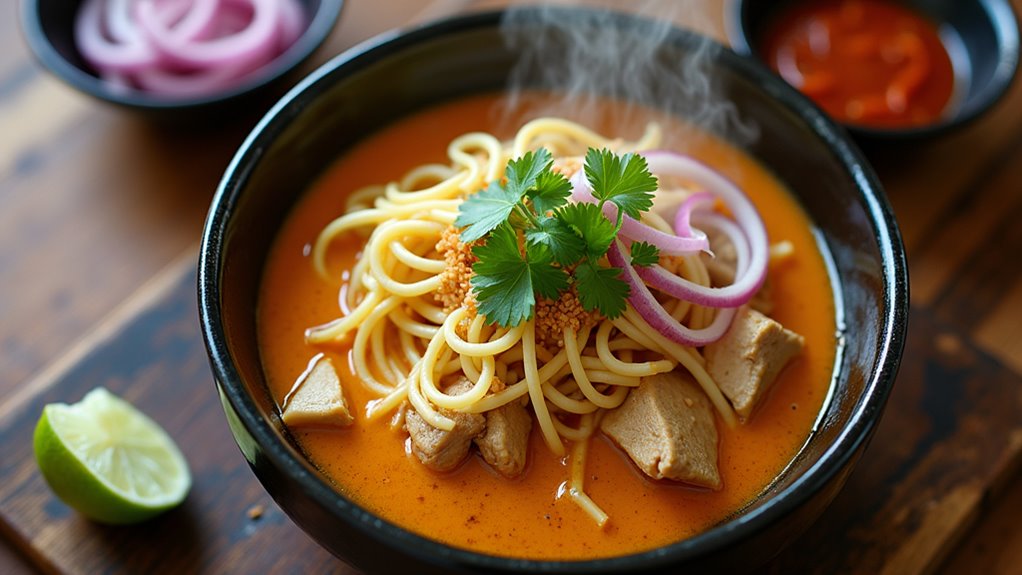
While green curry represents central Thailand’s culinary prowess, the northern regions showcase their own iconic dish with Khao Soi. This curry noodle sensation combines luscious coconut milk broth with turmeric and spices, served over wheat-based egg noodles and topped with crispy fried noodles.
Khao Soi stands as the North’s answer to Central Thailand’s curry dominance—a curry noodle masterpiece unlike any other.
When you visit Chiang Mai, you’ll discover why this Muslim-Chinese influenced dish has become a must-try:
Khao Soi perfectly represents northern Thailand’s distinct culinary traditions. Travelers exploring Thailand can enjoy this authentic dish while experiencing the welcoming atmosphere of the Land of Smiles, known for its rich food culture and hospitality.
Thailand’s vibrant street food scene represents the beating heart of the nation’s culinary identity. As you wander through bustling markets, you’ll encounter an explosion of sweet, sour, spicy, salty, and umami flavors prepared right before your eyes.
Don’t miss classics like Pad Thai with its tamarind-infused noodles or Som Tam’s invigorating spicy papaya salad.
For protein lovers, satay skewers offer perfectly grilled chicken or pork, while the adventurous can sample fried insects or whole grilled prawns. Thai street food culture emerged relatively recently, originating from Chinese enclaves in Bangkok in the 1970s. Whether you’re exploring the stunning Phi Phi islands or the bustling streets of Koh Samui, you’ll find incredible street food options at every turn.
End your street food journey with Thailand’s beloved desserts. Mango sticky rice combines glutinous rice with fresh mango and coconut milk, creating the perfect sweet finale.
Street vendors also offer palm sugar drinks and fresh-pressed fruit juices to help cool down between spicy bites.
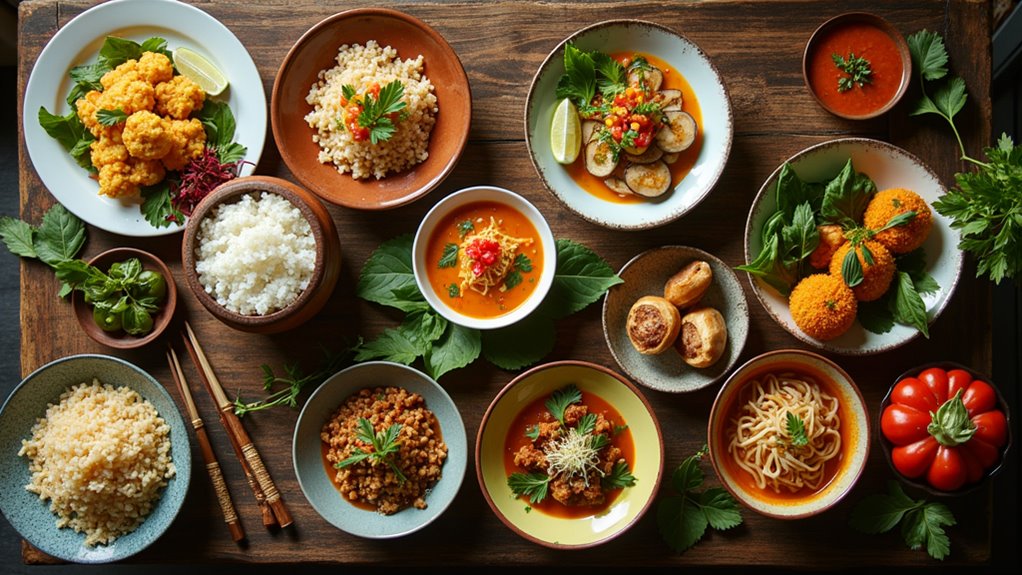
From the misty mountains of the north to the sun-drenched southern shores, Thailand’s regional cuisine reflects the country’s diverse geography and cultural influences.
As you travel through different provinces, you’ll discover that Thai food varies dramatically by region, each with its own distinctive flavors and cooking techniques.
When most visitors think of Thai desserts, mango sticky rice often comes to mind first, but Thailand’s sweet culinary landscape extends far beyond this famous dish.
You’ll find coconut milk taking center stage in treats like khao niao dam (black sticky rice pudding) and sankhaya (coconut custard steamed in pumpkin).
For invigorating options, try tub tim grob—water chestnuts coated in tapioca flour, dyed red, and served with coconut milk and ice—or the pandan-flavored rice noodles called lot chong.
Thai desserts are beloved for being naturally gluten-free and dairy-free, requiring no modifications for those with dietary restrictions.
Street markets offer delights like khanom krok (coconut-rice pancakes) and khanom bueang (crisp shells with coconut cream).
These markets showcase the authentic flavors that represent the heart of Thailand’s diverse culinary heritage.
Don’t miss traditional banana-wrapped khao tom mud or the layered, colorful khanom chan.
Modern fusion creations like coconut ice cream with sticky rice provide the perfect sweet ending to your Thai culinary adventure.
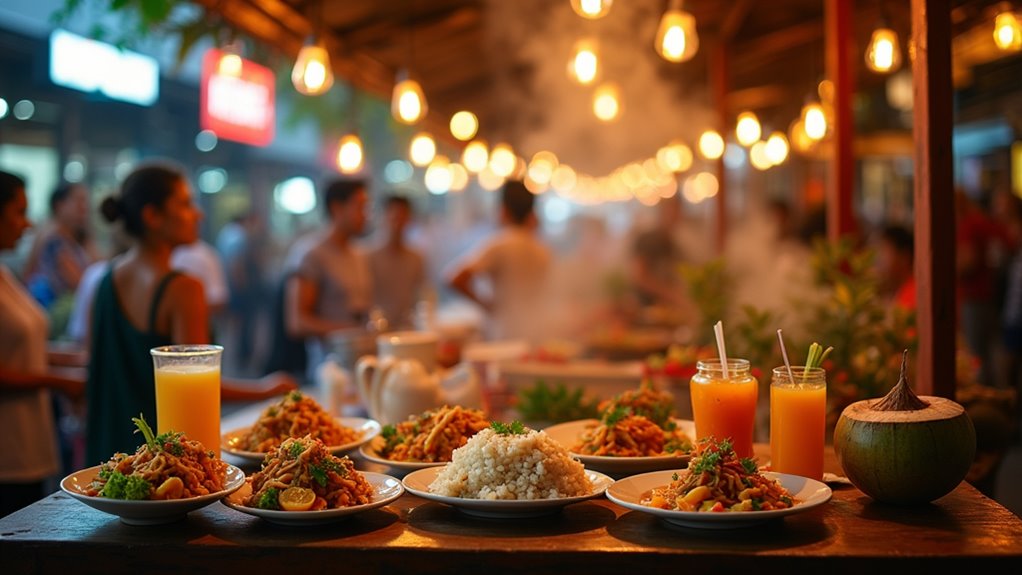
Thai cuisine’s perfect complement lies in its diverse array of beverages, each offering distinct flavors that enhance the dining experience. From cooling herbal infusions to sweet milk-based drinks, these beverages balance the complex spices found in Thai dishes.
As you’ve tasted your way through Thailand’s culinary landscape, you’ve only scratched the surface of this flavor paradise. From the fiery zing of Som Tam to the comforting embrace of Khao Soi, Thai cuisine is a vibrant tapestry woven with bold herbs, aromatic spices, and fresh ingredients. Don’t just eat in Thailand—dive headfirst into a food culture that’s as opulent as the land itself.